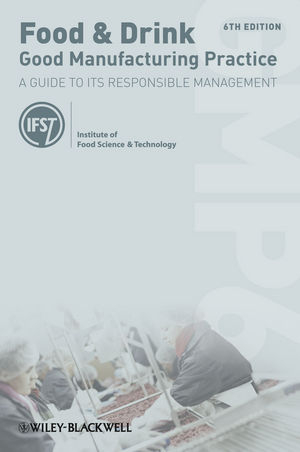
Food and Drink - Good Manufacturing Practice
Wiley-Blackwell (Verlag)
978-1-118-31820-1 (ISBN)
First launched in 1986, IFST’s Good Manufacturing Practice Guide has been widely recognized as an indispensable reference work for food scientists and technologists. It sets out to ensure that food manufacturing processes deliver products that are uniform in quality, free from defects and contamination, and as safe as it is humanly possible to make them. This 6th edition has been completely revised and updated to include all the latest standards and guidance, especially with regard to legislation-driven areas such as HACCP.
The Guide is a must have for anyone in a managerial or technical capacity concerned with the manufacture, storage and distribution of food and drink. It is also a valuable reference for food education, training and for those involved in food safety and enforcement. Food scientists in academic and industry environments will value its precision, and policy makers and regulatory organizations will find it an indispensable guide to an important and multifaceted area.
About IFST
IFST is the leading independent qualifying body for food professionals in Europe and the only professional body in the UK concerned with all aspects of food science and technology. IFST members are drawn from all over the world and from all ages and backgrounds, including industry (manufacturing, retailing and food service), universities and schools, government, research and development, quality assurance and food law enforcement. IFST qualifications are internationally recognised as a sign of proficiency and integrity.
IFST is the leading independent qualifying body for food professionals in Europe and the only professional body in the UK concerned with all aspects of food science and technology. IFST members are drawn from all over the world and from all ages and backgrounds, including industry (manufacturing, retailing and food service), universities and schools, government, research and development, quality assurance and food law enforcement. IFST qualifications are internationally recognised as a sign of proficiency and integrity.
Acknowledgements ix Prefaces ix
Decision Makers’ Summary xiii
Part I General Guidance
1 Introduction 1
2 Quality Management System 7
3 Hazard Analysis Critical Control Point (HACCP) 13
4 Food Allergens 23
5 Foreign Body Controls 31
6 Manufacturing Activities 39
7 Management Review and Internal Audit 49
8 Product and Process Development and Validation 53
9 Documentation 57
10 Product Identifi cation and Traceability 65
11 Personnel and Training 69
12 Premises and Equipment 85
13 Water Supply 101
14 Cleaning and Sanitation 105
15 Infestation Control 113
16 Purchasing 119
17 Packaging Materials 125
18 Internal Storage 129
19 Crisis Management, Complaints and Product Recall 133
20 Corrective Action 139
21 Reworking Product 143
22 Waste Management 147
23 Warehousing, Transport and Distribution 149
24 Contract Manufacture 155
25 Calibration 157
26 Product Control, Testing and Inspection 161
27 Labelling 165
28 Electronic Data Processing and Control Systems 169
29 Good Control Laboratory Practice
and Use of Outside Laboratory Services 173
30 Environmental Issues 181
31 Health and Safety Issues 185
Part II Supplementary Guidance on Some Specifi c Production Categories
32 Heat-Preserved Foods 189
33 Chilled Foods 197
34 Frozen Foods 207
35 Dry Products and Materials 213
36 Compositionally Preserved Foods 217
37 Foods Critically Dependent on Specific Ingredients 219
38 Irradiated Foods 221
39 Novel Foods and Processes 227
40 Foods for Catering and Vending Operations 231
41 The Use of Food Additives and Processing Aids 233
42 Responsibilities of Importers 237
43 Export 239
Part III Mechanisms for Review of This Guide
Appendix I Defi nition of Some Terms Used in This Guide 243
Appendix II Abbreviations Used in the Guide 251
Appendix III Legislation and Guidance 255
Appendix IV Additional References 257
Appendix V List of Organisations and Individuals from Whom Help, Information or Comment Has Been Received 261
| Verlagsort | Hoboken |
|---|---|
| Sprache | englisch |
| Maße | 173 x 244 mm |
| Gewicht | 494 g |
| Themenwelt | Technik ► Lebensmitteltechnologie |
| Weitere Fachgebiete ► Land- / Forstwirtschaft / Fischerei | |
| ISBN-10 | 1-118-31820-X / 111831820X |
| ISBN-13 | 978-1-118-31820-1 / 9781118318201 |
| Zustand | Neuware |
| Haben Sie eine Frage zum Produkt? |
aus dem Bereich



